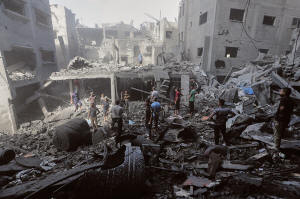US determined to prevent the collapse of the Gaza ceasefire after
overnight airstrikes
[October 30, 2025]
By JULIA FRANKEL
JERUSALEM (AP) — Israel’s intense bombardment of the Gaza Strip this
week marked the most serious challenge yet for a fragile, U.S.-brokered
ceasefire.
Over 100 Palestinians were killed, including dozens of civilians,
according to Gaza health officials. One Israeli soldier was killed in an
attack that helped prompt the fierce Israeli strikes.
But by early Wednesday, the ceasefire had been restored almost as
quickly as it had unraveled. President Donald Trump defended Israel’s
actions but also made it clear that the U.S. expects the broader
ceasefire, which began Oct. 10, to hold.
The chain of events underscored the fragility of the truce between
Israel and Hamas after two years of war, but also showed how intent the
U.S. is on keeping it going.
Here are some takeaways from the tense two-day standoff.
Trump will allow Israel to bomb, but won't let deal collapse
Trump has staked his personal reputation on the success of this deal and
poured diplomatic and military resources into making sure it succeeds.
Trump himself flew to the region to usher in the agreement, visiting
Israel and then meeting with key Arab and other international leaders in
Egypt.
Vice President JD Vance, Secretary of State Marco Rubio and two senior
advisers — White House envoy Steve Witkoff and Trump’s son-in-law, Jared
Kusher — have all visited Israel in recent days in a sign of the high
priority the U.S. places on the deal. The U.S. is also leading a new
international effort meant to coordinate aid shipments into Gaza and to
strengthen the agreement.
Speaking to reporters on Wednesday, Trump defended Israel’s actions,
saying it “should hit back” when its troops come under attack.

Yet he also signaled that he will keep Israel in check, saying he is
confident the ceasefire will stick.
Vance also tried to play down the violence, saying Tuesday that “the
ceasefire is holding.“
“That’s doesn’t mean there aren’t going to be little skirmishes here and
there,” he said.
Perceived truce violations will yield heavy Israeli response
The Israeli military has a long history of tough responses to enemy
attacks, and Tuesday night’s airstrikes were no exception.
Israel said it struck dozens of Hamas militants and military sites.
Palestinian health officials said that scores of women and children,
including a 1-year-old, were killed in the attacks.
Israel’s five wars against Hamas, along with recent conflicts with
Lebanon’s Hezbollah militant group and Hamas, have all been
characterized by lopsided death tolls with large numbers of civilian
deaths.
During the 12-day war between Israel and Iran earlier this year, for
instance, Iran said over 1,000 Iranians were killed. Israel’s government
said around 30 Israelis lost their lives in Iranian missile attacks.
[to top of second column]
|

Palestinians inspect the rubble of a building, destroyed by an
Israeli army strike at Al-Shati camp in Gaza City Wednesday, Oct.
29, 2025. (AP Photo/Yousef Al Zanoun)

Israel says it complies with international law and only strikes only
military targets, while accusing its enemies of using civilians as
human shields. But human rights groups have repeatedly accused
Israel of using disproportionate force.
Israel has no trust in Hamas
Since Hamas seized control of Gaza in 2007, Israel has said the
Islamic militant group is responsible for all violence emanating
from the territory.
That still appears to be the case, even when Hamas denies
involvement, as it did in Tuesday’s shooting of the Israeli soldier
in the southern Gaza city of Rafah.
Increasing the likelihood of further fighting, Netanyahu also faces
intense pressure from hard-liners to issue a punishing response to
any perceived violation of the truce.
With Israeli critics and media accusing Netanyahu of caving to
American pressure, the Israeli leader also has been eager to assert
his independence. Vance and other Israeli officials have rejected
suggestions that they are controlling Israeli actions.
After it announced the restoration of the ceasefire, the Israeli
military said Wednesday it carried out another airstrike in northern
Gaza, targeting what it called a site where weapons were being
stored for an imminent attack. Al-Shifa Hospital in Gaza City said
it received two bodies from the strike.
The ceasefire is stuck in its initial phases
Trump has presented a 20-point plan for the ceasefire, beginning
with the exchange of hostages, both dead and alive, for living and
deceased Palestinian prisoners.
The details of the next phase of the deal — disarming Hamas,
installing a new government in Gaza and deploying an international
security force -- are yet to be hammered out.
For now, the sides remain stuck in phase one. One of the triggers of
Tuesday’s violence was Hamas’ failure to return the remains of a
dead hostage, as it had promised.
Instead, it returned some body parts belonging to a hostage whose
remains had been recovered by Israel in late 2023. Israeli officials
also accused Hamas of staging the discovery of hostage remains on
Monday, sharing a 14-minute, edited video from a military drone in
Gaza.
With mistrust running deep, and the remains of 13 dead hostages
still in Gaza, the potential for additional bursts of violence
appears to remain high.
All contents © copyright 2025 Associated Press. All rights reserved |